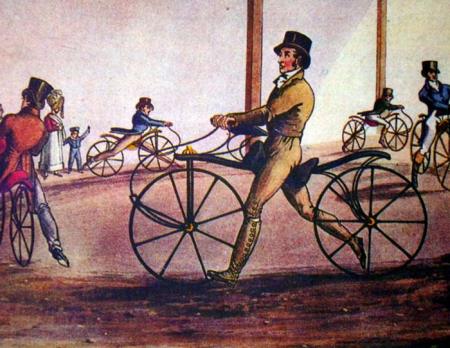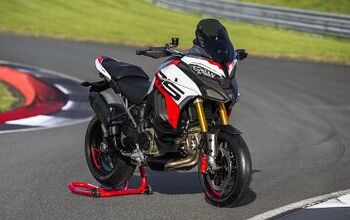Motorcycle History: Part 1
Modern motorcycles are wonders of technology and advances, but contemporary machines have been built on the backs of more than 100 years of development. There is a rich history of innovation and colorful characters that encompass the story of the motorcycle and how we’ve gotten to where we are now.
To tell the story of our two-wheel world, we enlisted the services of bike historian Paul Garson who begins his Motorcycle Milestones series with a look back at the origins of the species that stretches over the 19th century. –Ed.
Motorcycle Pre-History – the 1800s
“Before the beginning of great brilliance and beauty there first must be a period of complete chaos.” — I Ching
The story of the “motor-cycle” begins back in the early 1800s when bicycles were basically wooden hobby horses that you sat upon and paddled around using your feet, as these primitive devices lacked pedal and crank technology. Good for shoemakers, bad for the spine.
More efficient cranks and pedals attached to a wheel didn’t appear until 1861 when a Frenchman put it all together. Over the next two decades, a succession of two-, three- and four wheeled steam- and gasoline-powered cycles huffed, puffed and sputtered themselves into existence as the evolution of the motorcycle spawned ever newer, and occasionally better, designs across Europe and America.
By 1865, large front wheel/small rear wheel bicycle designs came to the forefront, eventually evolving into extremely tall front-wheeled cycles (aka the “penny-farthing”), some of which required a ladder to reach the saddle. A fall from such heights could have unpleasant consequences, so an effort was made to bring the velocipede rider closer to terra firma.
By1869 the first chain-driven bicycle was built, the same year the public was introduced to the first ever bicycle show which was held in Paris. The designs shown were a quantum leap forward, featuring lightweight metal frames with front suspension and solid rubber tires mounted on wire-spoked wheels. The growth of the bicycle industry also prompted the mass production of ball-bearings which in itself would engender far-reaching technological advances in general.
But with the disruption caused by the Franco- Prussian War in 1870-71, France would lose its lead, dropping the ball-bearing, so to speak, and thus opening the way for Britain to take the dominating role in bicycle production, which in turn would lead to other forms of the “cycle.”
The Dawn of the Twilight Zone of Motorcycles – Trikes
While today trikes are thought of as a modern variation somewhere in limbo between bike and car, three-wheelers or Tri-Cycles were a prevalent species, both on the street and at race events, at the end of the 19th century in England, Europe and the U.S. Three wheels made for a larger frame to carry the big powerplants of the day.
However, resistance was strong to such motorized contraptions, particularly from the fans of the horse. In fact, two promising motorized English tricycles, the Meek of 1877 and the Parkyns & Pateman of 1881, were squashed by the road vehicle laws of the day, particularly the Locomotive Acts of 1861 which restricted speeds to 4 mph and required footmen carrying lanterns to give warning of the beastly machine’s advance.
Steaming Into the Future
The question as to who built the first motorcycle, like many “Firsts” in history, has engendered many answers put forth by various professional and homespun historians who nominate their choice for owners of that crown. The variables that enter the not particularly clear picture of the primordial days of motorcycling include naturally the definition of a “motorcycle,” the locomotive force and the fuel consumed thereby, how many wheels, and largely the fickle factor of memory.
Richard Hough and L.J.K. Setright may have set it right (sorry) in the 1977 revised edition of their 1966 published “A History of the World’s Motorcycles,” wherein the authors point to steam as being the first driving force of what tentatively qualifies as a motorcycle. As far back as 1818 via German cartoons and drawings were showing a two-wheeler “hobby horse” equipped with a rear-mounted boiler.
More accurate accounts attest to the actuality of a steam powered “bone shaker,” a machine built in 1868 by the Frenchman Michaux, utilizing a single-cylinder Pereaux steam engine driving the rear wheel by pulley. According to moto historian Charles Falco in his “Motorcycling at the Turn of the Century,” the Michel steam-powered bicycle reached a claimed speed of about 9 mph.
Meanwhile, American Sylvester H. Roper was working on his own steam-powered motorcycle that first debuted in 1869. Roper, a New Hampshire resident, developed his interest in steam power during the Civil War era while working at the Springfield Armory.
Three years after that conflict ended, he had constructed his steam-powered “bike,” the twin-piston boiler planted in a vertical position under its seat, a crank motivating the rear wheel. This compact boiler also served as a water reservoir. The amount of steam released was controlled by a throttle twistgrip design on the handlebar, and may well be the first appearance of the now standard twistgrip throttle, although Glenn Curtiss (and later Indian) was credited with establishing that innovation.
Roper was definitely an advanced thinker and tinker of his day, and he went on to design four-wheelers while further developing his motorcycle designs. In June 1896 at the ripe age of 73, he rode one of his further-developed steam motorcycles around a Harvard-area bicycle track to an astounding 40 mph. As it turned out, he went out in a blaze of glory. Roper fell from his mount at the track and expired – not from the crash, but rather from a heart attack.
Although the internal-combustion engine eclipsed early steam-powered motorcycle design, we give a shout-out to Roper who earned his place among the Milestones of Motorcycling.
The Dawn of the Internal-combustion Engine in Motorcycles
In 1885, German Gottlieb Daimler came up with the first motorcycle powered by an internal combustion engine, a wooden-framed device called the Einspur or “one track,” a choice of names that would also echo the beginning of the motorcycle phenomena that would keep “on track” literally through the centuries.
The next milestone in the evolution of the bicycle – and one that literally smoothed out its evolution – took place in 1888 in Belfast, Ireland, where a horse veterinarian came up the first air-inflated pneumatic tire. His name, John Boyd Dunlop, now rolls off all biker’s tongues.
Inventors came up with additional enhancements for the bicycle, including sunshades that also could be used as sails. Even less successful adaptations appeared in the form of tricycles, quadricycles and even octocycles, the larger sizes configured to carry more weight, but only placed the burden on the rider, and so these peculiar designs passed out of favor.
The “Bicycle Boom” hit Europe in 1890, the public clamoring for the safer, more user-friendly forms of the machine with a resulting meteoric growth of the industry. There’s no missing link between the bicycle and the motorcycle, as even the names gives away the natural evolutionary leap.
Remember that the first Indian was labeled a “Moto-Cycle.” Plugging a motor into a spindly bicycle frame came naturally as the combustion engine appeared on the scene. As bicycle production for sport, leisure and daily transport became dominated by British companies like BSA and Triumph at the leading edge, they were the natural birthplaces for motorcycles.
Hildebrand & Wolfmuller – World’s First Production MotorcycleIt wasn’t until1894 (the same year the world’s first motoring contest, the Paris-Rouen race, was held) that things began to coalesce. The year brought profound changes from advances synthesized from German, French and British designers and manifested in one of the seminal machines of motorcycling: the Hildebrand & Wolfmuller.
The stage was set: Munich, Germany, 1894. Not far away in Russia, Nicholas II, the last of the pre-Soviet czars had ascended the throne while further east China and Japan were at war in Korea.
However, politics and empire building were of little interest to brothers Heinrich and Wilhelm Hildebrand. They were busy revolutionizing human transportation. True, their initial focus had been on building steam-powered machines in an effort to conquer the steep inclines of their beloved Bavarian hills, but it was a start, if a hot and bubbly one.
After a period of steamy experimentation, Heinrich and Wilhelm discovered that a bunch of hot air could only take you so far. Being bright and industrious lads, the Hildebrands decided to join forces with two nimble-minded engineers Alois Wolfmuller and Hans Geisenhof, both residents of nearby Langsberg, a few kilometers from Munich. Geisenhof brought some extra clout to the party as he had been a member of the Benz automobile group and knew his way around engines.
Also in 1895 Michelin in France introduced pneumatic tires capable of supporting heavyweight autos.
American Evolution
Development of the motorcycle in America was intense, as early motor-cycles were adapted and taken one step further.
An important chapter in the proto-history and development of today’s modern machines began in 1881 when Phoenix, Arizona, engineer Lucius Copeland designed a steam-powered two-wheeler called the “Star,” but he couldn’t drum up financial backing until he built a tricycle version in his Camden, NJ, Northrop Manufacturing Co. facility. Copeland is credited in 1887 with inventing the first successfully mass-produced three-wheeled car which he named “Phaeton Steamers,” some 200 built before he retired in 1891.
Meanwhile, on the East Coast, Charles H. Metz added his input to the evolution of the motorcycle (noted as America’s first motorcycle company) when in 1893 he founded the Waltham Manufacturing Co. (a spin-off of the Waltham watch company), first building bicycles, then launched in various forms of motor-cycles and auto-mobiles.
Shades of Evel Knievel aside, this bit of advertizing balderdash from 1896 was thought up one E.J. Pennington, an American who made his way to England with a seemingly marvelous motorcycle design that, according to Pennington, was fueled on paraffin wax.
The above illustration helped the inventive Pennington to sell his patent for the then very hefty sum of 100,000 English Pounds to an Englishman, himself a speculator who wanted to dominate British car and motorcycle production, but who went bankrupt. Pennington, a stellar flim-flam man, laughed all the way to the bank, and not the one on the far side of the river, his motorcycles have never gone into production.
Metz is credited with coining the term "motor cycle," first used in an 1899 advertisement. Metz called his creation an Orient “Auto-mobile” at the time, the machine able to be converted from a three- to a four-wheeled vehicle. (He called it the Orient because he once worked at the Orient Fire Insurance Co.)
You had a choice of locomotion: pedal it, propel it by its engine or use both pedal power and engine power. Costing a hefty $450, the water-cooled 2.75-hp vehicle could cruise “comfortably” between 10-50 mph and travel about 50 miles before you needed to refill it with naphtha, gasoline or petroleum.
The Waltham factory promoted the roadworthiness by sending an employee on a 251-mile road trip from Waltham to NYC. Travel time was 17 hours while expenses were 40 cents for fuel and five cents for lubricating oil.
Metz would go on to build two-wheeled machines that would also earn him a special page in the history books. Metz first introduced his two-wheeled creation to the world in July 1900, at the Charles River Race Track in Boston, marking the first recorded motorcycle speed event in the United States.
More by G.P. Garson





































Comments
Join the conversation